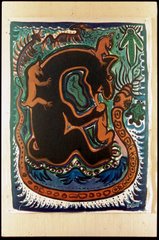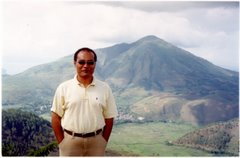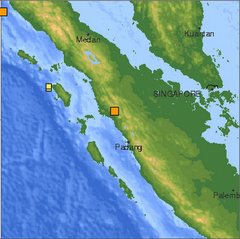
School children at Sibanggor Julu, Upper Mandailing
Anak-anak sekolah di Sibanggor Julu, Mandailing Julu
Foto Arbain Rambey
Mandailing People (Sumatra)
Anak-anak sekolah di Sibanggor Julu, Mandailing Julu
Foto Arbain Rambey
Mandailing People (Sumatra)
Published in The Encylopedia of Religion and Nature, London: Thoemmes Continuum, Vol. 2, 2005, pp. 1037-8.
The Mandailing people in northwest island of Sumatra are a clan-based society with an indigenous tradition of representative and consultative governance. They are well known for their ancient tree-bark books, their contribution to modern Malaysian and Indonesian literature as well as their ritualistic music of the Nine Great Drums. They practice an indigenized brand of Islam where customs and customary usage is considered close to religion. Their habitat ranges from well-irrigated highlands with volcanoes to marshy lowlands. Their tropical rainforest is rich in biodiversity with, amongst others, Sumatran tigers, rhinoceros, serows and Rafflesia flowers. Their productive economy is based on paddy, rubber, palm sugar, cinnamon, coffee and gold mining. ‘Mandheling Coffee’ is famous amongst coffee connoisseurs today. There are over 300,000 Mandailings in the homeland in Sumatra, and with about equal numbers throughout the rest of Indonesia and an estimated 200,000 or so, in Malaysia. The Mandailing homeland is today called the regency of Mandailing-Natal (Madina), in the province of North Sumatra, Indonesia.
The environmental worldview of the Mandailing people is embedded in its language, folklore and cultural heritage. The great epic of the Mandailing people, speak of the elements, the sky and the earth. The recitation of the epic invokes the earth, water and habitat guardian. The story-teller employs five different types of languages to transmit the oral tradition, including that of the camphor-gatherers as well as proverbs and maxims.
The epic begins with, “Once upon a time in the primordial past, the plant kingdom flourished and its flowers and fruits were abundant....” The symbolism used in the epic which forms the essence of Mandailing ethics and governance point to a way of life that is intimately bound to the forest and natural habitat.
This close connection to the habitat that they lived in is also reflected in the place names, which is named after rivers, trees, mountains and such. Names of soil types also reflect an intimate relationship with ‘nature’. For example, a fertile land is called green land.
Mandailing tradition defined the classical role of the Mandailing leader in naturalistic terms. The Mandailing nobleman is likened to the baringin tree, a place of shelter; its spreading roots a place of protection, its canopy a cover for the head. The nobleman’s acute sense of hearing is likened to the rhinoceros.
Traditional Mandailing society has a few key concepts on division of land resources, territoriality and jurisdiction, and the management of resources. Central to these are the notion of a politically unified territory held together by customary law that secures territorial integrity as well as control over resources.
This set up has a defined territory, citizen and jurisdiction governed by a council of nobles and elders representing clans, nobility, religious functionaries headed by a chief. The strong connection of a Mandailing to his or her territoriality is testified by the fact that when two Mandailings meet, they first and foremost ask which territoriality the other is from.
Elements representing the animal kingdom feature prominently in the houses of the nobles and elders called ‘house with horns’ or ‘house of ornaments’. The horns symbolize the sacrificial buffalo, sacrificed during ceremonial and ritualistic occasions.
In a typical Mandailing settlement, the chief's dwelling and the council hall are far more important and significant than the mosque. These two customary buildings reflect the status of the settlement as an autonomous entity.
In the chief’s dwelling, the sacred Nine Great Drums are placed. It is played at customary ceremonies such as weddings and installations, and ceremonies to mark the death of the nobleman. The death of a tiger, described as the king of the forest, is similarly commemorated.
In Mandailing society, the management of the environment is tied to the origin of clans and settlement, social structure, system of land tenure, governance and sense of territory. Mandailing society in the past and up to this day is a rural, agrarian and pastoral society. The main agricultural activity is paddy planting. Ownership of a plot of paddy land is critical to Mandailing social life as it defines ones’ standing and status in society.
In the Mandailing perspective, a territorial unit is only complete when it constitutes land and water. The land and water in a settlement is communally owned and its usage has to conform to the customs as well as the sanction of the council of nobles and elders.
The water systems in Upper Mandailing are a feat of traditional water management and engineering. An extensive irrigation system provides for religious, domestic, agricultural and other uses. As such, settlements are strung all along the streams and river banks, traversed by path and canals leading to the paddy fields. One can hear the water flowing 24 hours a day in a typical Mandailing settlement.
Mandailing settlements are always located near a spring, stream or a river, which is used for domestic, agriculture, fisheries and religious/ritualistic purposes. Each territorial unit has its own protected forest area, where agriculture, hunting and harvesting of forest products are prohibited. These are usually are watershed areas, believed to be where the spirits lived.
Inspired by the traditional concept of protected areas, local communities in the Mandailing homeland have been overseeing the implementation of the river protection program. The practice prohibits the harvesting of fisheries resources close to human settlements for a stipulated period. Implemented in 70 settlements, Mandailing has the largest river protection scheme in the province of North Sumatra.
The income derived the harvesting of river resources is used to pay for the development of social facilities such as schools, roads and mosques, providing educational scholarships and administrative salaries, charity towards orphans, poor and invalids, etc. The income generated by this community-based ecological resource management program benefits the community directly.
Both mother and child 'village republics' are autonomous in implementing their system of governance. The general rule is that the chief of the Nasution clan rules settlements in Lower Mandailing whilst the nobleman of the Lubis clan rules settlements in Upper Mandailing, but there are exceptions.
The Mandailing nobleman governs in council, in that, he acts in concert with his counsels. The nobles and elders jointly carry out their duties and obligations of governance and customary laws, which covers not only social and ceremonial matters such as marriage but also matters of local governance such as division of new paddy lands, rights of water and pastoral land, and so forth.
Although the territorial units were terminated by the Japanese imperial army in the 1940s, which meant that the nobles and elders lost their territoriality and powers to function effectively in Mandailing society, it did not wipe them out of existence and to this day, the nobles and elders still play a recognized role as arbiters of the customs although their authority is circumscribed.
Abdur-Razzaq Lubis, Independent Scholar/Activist (Penang Island, West Malaysia)
Further Reading
Kartomi, Margaret. "Lovely When Heard From Afar": Mandailing Ideas of Musical Beauty in Five Essays On The Indonesian Arts - Music, Theatre, Textiles, Painting and Literature, (Monash, Australia: Monash University, 1981), pp. 1-16..
Harahap, Basyral Hamidy. “Islam and Adat Among South Tapanuli Migrants in Three Indonesian Cities” in Rita Smith Kipp & Susan Rodgers (Eds.), Indonesian Religions in Transition. Tucson, Arizona: The University of Arizona Press, 1987, pp. 221-37.
Harahap, Basyral Hamidy. The Political Trends of South Tapanuli and its Reflection in the General Elections (1955, 1971 and 1977), in Rainer Carle (Ed.) Cultures and Societies of North Sumatra, Dietrich Reimer Verlag, 1989.
Lubis, Abdur-Razzaq. Transformation of Mandailing Cultural Identity and Leadership. Journal of the Malaysian Branch of the Royal Asiatic Society (JMBRAS) 76, part 1, 2003.
Lubis, Abdur-Razzaq and Khoo Salma Nasution, Raja Bilah and the Mandailings in Perak, 1875-1911, (Monograph No. 35). MBRAS, Kuala Lumpur, 2003.
Lubis, Drs. Z. Pangaduan, ‘Ideas of Governance in the Built Heritage of Mandailing, Sumatra’, Asia & West Pacific Network for Urban Conservation (AWPNUC) Newsletter 5 (3) 1999, pp. 7-9.
Tugby, Donald. Cultural Change and Identity: Mandailing Immigrants in West Malaysia, St. Lucia, Australia: University of Queensland Press, 1977.
Tugby, Donald J. The Social Function of Mahr in Upper Mandailing, Sumatra, American Anthropologist 61 (4) 1959, pp. 631-640.
Traditional Buildings Of Indonesia, Batak Simalungun and Batak Mandailing, Vol. 3, United Nations - Regional Housing Centre - ESCAFE, Bandung, 1973.



1 comment:
Thanks for writing, I truly enjoyed reading your latest post. I think you should post more frequently, you evidently have talent for blogging!
http://sihepenghsb.wordpress.com/
Post a Comment